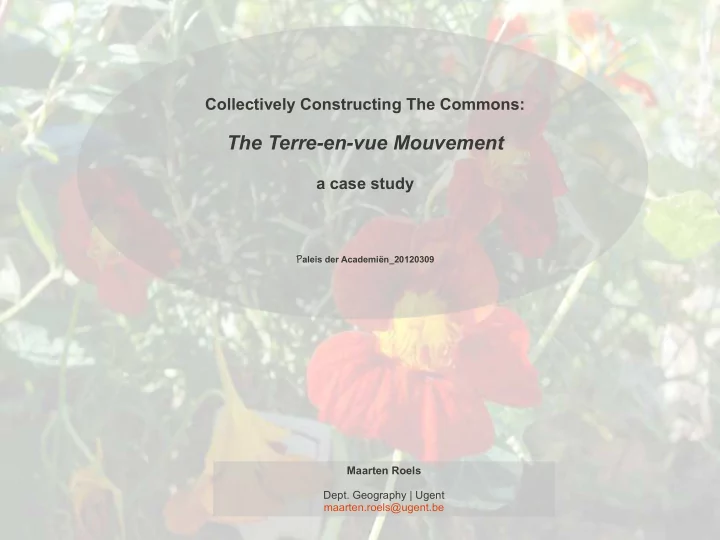

Collectively Constructing The Commons: The Terre-en-vue Mouvement a case study P aleis der Academiën_20120309 Maarten Roels Dept. Geography | Ugent maarten.roels@ugent.be
objective conditions in which the movement acts high fragmentation between urban and rural activities low interaction between (potential) providers and (potential) appropriators => citizen lack of awareness about trends in agriculture, soil and biodiversity quality, lack of empowerment longer food supply chains lower incomes for primary producers (farmers) => decrease of economic profitability, attractiveness and willingness to experiment increased benefit seeking in economies of scale => increasing demand for land and rising prices
agriculture in Belgium, the tragedy of the commons 2.0 41
common sense and the genealogy of the Terre-en-vue Mouvement 2010 creation of a NGO network (formerly called platform) • feb. 2011 constitution of a peer group called dynamo • feb. 2011 start-up local project in Wavreille • may 2011 constitution of a citizen arena called forum • oct. 2011 consolidation of the dynamo-forum collaboration in the NGO called • Terre-en-vue (dynamo > board, forum > GA, task force > commission) feb. 2012 constitution of a land trust task force ( Groupe de travail Foncière ) • march '12 constitution of cooperative company called Terre-en-vue • march '12 first rendering of land into common resource by co-op Terre-en-vue • april 2012 constitution of communication task force • june 2012 Completion of the Terre-en-vue mouvement with a fondation •
basic questions What resource are we talking about Who are the owners Who are the users What rules are needed Who sets the rules How are the rules set and changed Who checks compliance to the rules, monitors
what resource are we talking about
who are the owners – land providers Citizens Terre-en-vue NGO Partner NGOs Local Teams Donors Foundation Terre-en-vue Share A Share B Co-op Terre-en-vue
who are the users – land appropriators / farmers existing farmers who seek continuity ● only 30 % of our farmers own their land the majority of our farmers is aged between 50 and 60 years potential farmers who seek land to start their projects on ● basic average start up capital between 25.000 and 50.000 agriculture is high risk economic sector if not well embedded in local needs
what rules are needed access rules ● for Terre-en-vue Co-op investors to CO-OP rights: statutes for Terre-en-vue NGO and local team members to the NGO rights: statutes, by laws and charter for farmers to land use rights: statutes, by-laws, charter, contract organisational rules ● participative instruments and dynamics created in NGO Terre-en-vue: General Assembly (arena), Task Forces (Commissions) & Board (Dynamo) + mutual follow up and refinement rules participative instruments and dynamics, and guarantee architecture created in CO-OP Terre-en-vue: General Assembly (arena), Task Forces & Supervisory Team (Commissions) & Board + mutual follow up and refinement + balance between NGO and CO-OP
who sets the rules - NGO Dynamo (Board) Local Teams Task Forces (Commissions) Local Teams Local Teams Arena (General Assembly)
who sets the rules - CO-OP Citizens (non farmers and farmers) Full decisive power Local Teams NGOs (Terre-en-vue and others) Share A Share B General Assembly decisive power Limited Commissions Board
how are the rules set and changed LEGAL FRAMEWORK: STATUTES PROCESS DYNAMICS: “SOCIOCRATY” participation, respect, the power of silence, inclusion
who checks compliance to the rules and monitors & how
Terre-en-vue & Ostrom's rule levels (Ostrom 1990) Constitutional Rules Collective Choice Rules Operational Rules Formulation Policy Making Appropriation Governance Management Provision Adjudication Adjudication Monitoring Enforcement
Terre-en-vue & Ostrom's design principles (Ostrom 1990) Clearly define bouderies strong (user rights and CPR) Congruence between strong appropriation & provision rules and local conditions Collective Choice Arrangements strong Participation of those affected by operational rules in change of these rules Monitoring n Monitors are accountable to the appropriators or are the appropriators Graduated Sanctions n Conflict resolution mechanisms n Minimal recognition of rights to organise n External governmental agencies do not create obstacles to th appropriators to device their own institutions Nested Enterprises strong Organisation of appropriation, provision, monitoring, enforcement, conflict resolution and governance activities in multiple layers n = no data yet
Recommend
More recommend